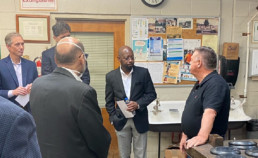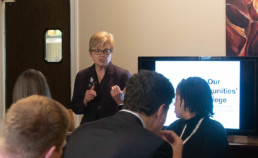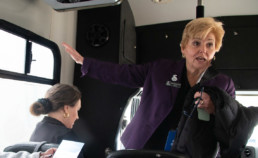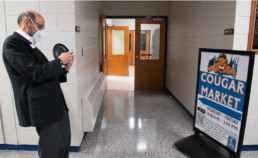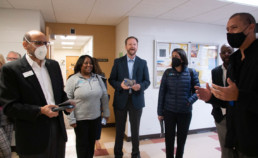Lee County March 2021
Population
64,138
County Seat
Sanford
Median Income
$52,294
Population Density Designation
Rural
The dogwood trees were flowering for our springtime visit to Lee County. Dr. Lisa Chapman, President of Central Carolina Community College (CCCC), facilitated a quick tour of the Lee County campus alongside Kelvin Hunt, Director of Student Onboarding and Outreach. Joining us were Sen. Jim Burgin (R) and Rep. John Sauls (R), both of whom represent Lee County in the General Assembly.
A rural county in the central part of the state, Lee has a growing population of more than 61,000 residents. The poverty rate in Lee County is 14.2%─ higher than the state average of 12.3%. It’s one of the state’s smallest counties in terms of land, but Chapman and company made the case that it has a significant amount of industry for the size of the county.
Our first stop at the main CCCC campus was the engineering building where Edwin Thomas, Chair of the Machining/Tool & Die program, told us about the unique challenges his department faced during the pandemic. Machining doesn’t lend itself to virtual learning according to Thomas, “So the issue isn’t jobs, it’s having enough people to fill them.”
Thomas has tried to address this challenge by inviting vocational students from high schools in Lee, Harnett and Chatham counties to visit the CCCC campus to help with recruiting.
Next, we dropped in on the Veterinary Medical Technology program, one of only three such programs offered by the state’s community colleges. Justin Pedley, the Animal Facilities Manager, showed us dogs and cats receiving medical care at the facility and available for adoption. He also told us about a new large-animal facility scheduled to open in 2023. CCCC is working with North Carolina State University’s world-class College of Veterinary Medicine on the design “… to get it right the first time,” according to Pedley.
President Chapman, members of her team and other community stakeholders joined us for an economic development panel over lunch at Café 121 in Sanford.
The lunchtime panel included Jimmy Randolph, CEO of the Sanford Area Growth Alliance (SAGA). SAGA was formed in 2014 to create a public/private partnership between the Sanford Chamber of Commerce and local employers. Randolph said the unemployment rate in the area was 16% just a few years ago but is now hovering around 4%─close to the national rate. He attributed this employment growth in part to CCCC’s workforce development efforts.
One such effort is the Central Carolina Promise Program. High school students in Chatham, Harnett and Lee counties who successfully complete four community college classes as part of their high school education are guaranteed two years of free schooling at CCCC. According to Scott Byington, Associate VP of Onboarding & Advising, half of the students who go to college in those three counties attend CCCC. As Meghan Brown, Executive Director of College Access & Strategic Initiatives, put it, “The secret of our community colleges is that we do a lot with a little. But man, you should see what we do with more!”
We wrapped up lunch and our visit to Lee County with a presentation from Margaret Roberton, VP of Workforce Development at CCCC. She told us about the upcoming completion of the E. Eugene Moore Manufacturing and Biotech Solutions Center. Named in recognition of a former student’s $2 million donation to his alma mater, this new center will be located in a former auto parts manufacturing facility. With support from the Lee County Commissioners, CCCC purchased the facility and will repurpose it to train future generations of CCCC students.

Meet Dr. Algie Gatewood
Dr. Algie Gatewood is only the fourth President to lead Alamance Community College (ACC) since it opened in 1958. During Dr. Gatewood’s tenure at ACC, the college won its largest ever bond referendum – nearly $40 million – in 2018 to fund a number of major capital projects and expansions. The college also secured $16 million in county funding in 2014 to build the Advanced Applied Technology Center. Other notable accomplishments include creating a Biotechnology Center of Excellence, introducing an Early College, facilitating an apprenticeship program, and introducing nearly two dozen new academic programs and articulation agreements with state universities.
U39702, 12/22


